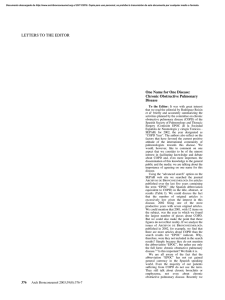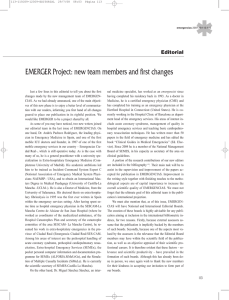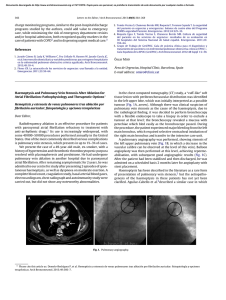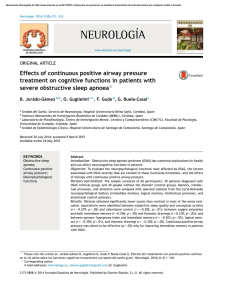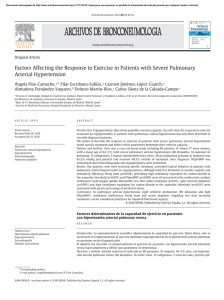examination and even fell asleep on the chair in the consul
Anuncio
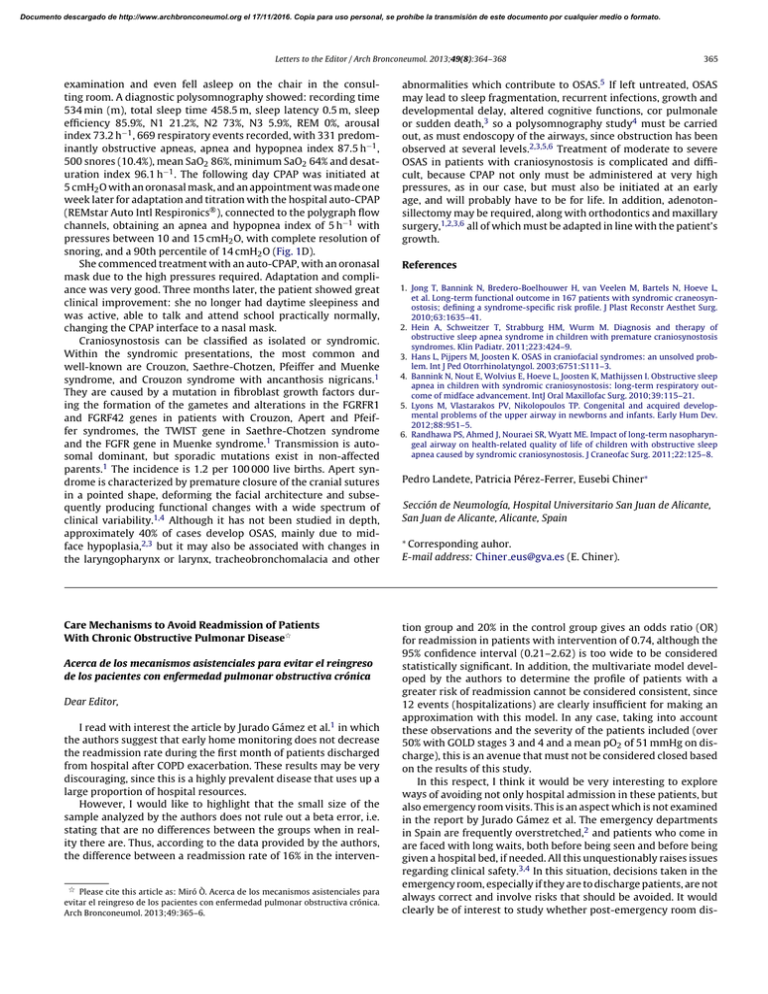
Documento descargado de http://www.archbronconeumol.org el 17/11/2016. Copia para uso personal, se prohíbe la transmisión de este documento por cualquier medio o formato. Letters to the Editor / Arch Bronconeumol. 2013;49(8):364–368 examination and even fell asleep on the chair in the consulting room. A diagnostic polysomnography showed: recording time 534 min (m), total sleep time 458.5 m, sleep latency 0.5 m, sleep efficiency 85.9%, N1 21.2%, N2 73%, N3 5.9%, REM 0%, arousal index 73.2 h−1 , 669 respiratory events recorded, with 331 predominantly obstructive apneas, apnea and hypopnea index 87.5 h−1 , 500 snores (10.4%), mean SaO2 86%, minimum SaO2 64% and desaturation index 96.1 h−1 . The following day CPAP was initiated at 5 cmH2 O with an oronasal mask, and an appointment was made one week later for adaptation and titration with the hospital auto-CPAP (REMstar Auto Intl Respironics® ), connected to the polygraph flow channels, obtaining an apnea and hypopnea index of 5 h−1 with pressures between 10 and 15 cmH2 O, with complete resolution of snoring, and a 90th percentile of 14 cmH2 O (Fig. 1D). She commenced treatment with an auto-CPAP, with an oronasal mask due to the high pressures required. Adaptation and compliance was very good. Three months later, the patient showed great clinical improvement: she no longer had daytime sleepiness and was active, able to talk and attend school practically normally, changing the CPAP interface to a nasal mask. Craniosynostosis can be classified as isolated or syndromic. Within the syndromic presentations, the most common and well-known are Crouzon, Saethre-Chotzen, Pfeiffer and Muenke syndrome, and Crouzon syndrome with ancanthosis nigricans.1 They are caused by a mutation in fibroblast growth factors during the formation of the gametes and alterations in the FGRFR1 and FGRF42 genes in patients with Crouzon, Apert and Pfeiffer syndromes, the TWIST gene in Saethre-Chotzen syndrome and the FGFR gene in Muenke syndrome.1 Transmission is autosomal dominant, but sporadic mutations exist in non-affected parents.1 The incidence is 1.2 per 100 000 live births. Apert syndrome is characterized by premature closure of the cranial sutures in a pointed shape, deforming the facial architecture and subsequently producing functional changes with a wide spectrum of clinical variability.1,4 Although it has not been studied in depth, approximately 40% of cases develop OSAS, mainly due to midface hypoplasia,2,3 but it may also be associated with changes in the laryngopharynx or larynx, tracheobronchomalacia and other Care Mechanisms to Avoid Readmission of Patients With Chronic Obstructive Pulmonar Disease夽 Acerca de los mecanismos asistenciales para evitar el reingreso de los pacientes con enfermedad pulmonar obstructiva crónica Dear Editor, I read with interest the article by Jurado Gámez et al.1 in which the authors suggest that early home monitoring does not decrease the readmission rate during the first month of patients discharged from hospital after COPD exacerbation. These results may be very discouraging, since this is a highly prevalent disease that uses up a large proportion of hospital resources. However, I would like to highlight that the small size of the sample analyzed by the authors does not rule out a beta error, i.e. stating that are no differences between the groups when in reality there are. Thus, according to the data provided by the authors, the difference between a readmission rate of 16% in the interven- 夽 Please cite this article as: Miró Ò. Acerca de los mecanismos asistenciales para evitar el reingreso de los pacientes con enfermedad pulmonar obstructiva crónica. Arch Bronconeumol. 2013;49:365–6. 365 abnormalities which contribute to OSAS.5 If left untreated, OSAS may lead to sleep fragmentation, recurrent infections, growth and developmental delay, altered cognitive functions, cor pulmonale or sudden death,3 so a polysomnography study4 must be carried out, as must endoscopy of the airways, since obstruction has been observed at several levels.2,3,5,6 Treatment of moderate to severe OSAS in patients with craniosynostosis is complicated and difficult, because CPAP not only must be administered at very high pressures, as in our case, but must also be initiated at an early age, and will probably have to be for life. In addition, adenotonsillectomy may be required, along with orthodontics and maxillary surgery,1,2,3,6 all of which must be adapted in line with the patient’s growth. References 1. Jong T, Bannink N, Bredero-Boelhouwer H, van Veelen M, Bartels N, Hoeve L, et al. Long-term functional outcome in 167 patients with syndromic craneosynostosis; defining a syndrome-specific risk profile. J Plast Reconstr Aesthet Surg. 2010;63:1635–41. 2. Hein A, Schweitzer T, Strabburg HM, Wurm M. Diagnosis and therapy of obstructive sleep apnea syndrome in children with premature craniosynostosis syndromes. Klin Padiatr. 2011;223:424–9. 3. Hans L, Pijpers M, Joosten K. OSAS in craniofacial syndromes: an unsolved problem. Int J Ped Otorrhinolatyngol. 2003;6751:S111–3. 4. Bannink N, Nout E, Wolvius E, Hoeve L, Joosten K, Mathijssen I. Obstructive sleep apnea in children with syndromic craniosynostosis: long-term respiratory outcome of midface advancement. IntJ Oral Maxillofac Surg. 2010;39:115–21. 5. Lyons M, Vlastarakos PV, Nikolopoulos TP. Congenital and acquired developmental problems of the upper airway in newborns and infants. Early Hum Dev. 2012;88:951–5. 6. Randhawa PS, Ahmed J, Nouraei SR, Wyatt ME. Impact of long-term nasopharyngeal airway on health-related quality of life of children with obstructive sleep apnea caused by syndromic craniosynostosis. J Craneofac Surg. 2011;22:125–8. Pedro Landete, Patricia Pérez-Ferrer, Eusebi Chiner∗ Sección de Neumología, Hospital Universitario San Juan de Alicante, San Juan de Alicante, Alicante, Spain ∗ Corresponding auhor. E-mail address: Chiner eus@gva.es (E. Chiner). tion group and 20% in the control group gives an odds ratio (OR) for readmission in patients with intervention of 0.74, although the 95% confidence interval (0.21–2.62) is too wide to be considered statistically significant. In addition, the multivariate model developed by the authors to determine the profile of patients with a greater risk of readmission cannot be considered consistent, since 12 events (hospitalizations) are clearly insufficient for making an approximation with this model. In any case, taking into account these observations and the severity of the patients included (over 50% with GOLD stages 3 and 4 and a mean pO2 of 51 mmHg on discharge), this is an avenue that must not be considered closed based on the results of this study. In this respect, I think it would be very interesting to explore ways of avoiding not only hospital admission in these patients, but also emergency room visits. This is an aspect which is not examined in the report by Jurado Gámez et al. The emergency departments in Spain are frequently overstretched,2 and patients who come in are faced with long waits, both before being seen and before being given a hospital bed, if needed. All this unquestionably raises issues regarding clinical safety.3,4 In this situation, decisions taken in the emergency room, especially if they are to discharge patients, are not always correct and involve risks that should be avoided. It would clearly be of interest to study whether post-emergency room dis- Documento descargado de http://www.archbronconeumol.org el 17/11/2016. Copia para uso personal, se prohíbe la transmisión de este documento por cualquier medio o formato. 366 Letters to the Editor / Arch Bronconeumol. 2013;49(8):364–368 charge monitoring programs, similar to the post-hospital discharge programs studied by the authors, could add value to emergency care, while minimizing the risk of emergency department revisits and/or hospital admission, both recognized quality markers in the care of patients with COPD5 and in dispensing urgent medical care.3 References 1. Jurado Gámez B, Lady K, Williams C, Feu Collado N, Hansen W, Jurado García JC, et al. Intervención domiciliaria y variables predictoras para reingreso hospitalario en la enfermedad pulmonar obstructiva crónica agudizada. Arch Bronconeumol. 2013;49:10–4. 2. Flores CR. La saturación de los servicios de urgencias: una llamada a la unidad. Emergencias. 2011;23:59–64. Haemoptysis and Pulmonary Vein Stenosis After Ablation for Atrial Fibrillation: Pathophysiology and Therapeutic Options夽 Hemoptisis y estenosis de venas pulmonares tras ablación por fibrilación auricular: fisiopatología y opciones terapéuticas Dear Editor, Radiofrequency ablation is an effective procedure for patients with paroxysmal atrial fibrillation refractory to treatment with anti-arrhythmic drugs.1 Its use is increasingly widespread, with some 40 000–50 000 procedures performed annually in the United States. One of the most commonly described serious complications is pulmonary vein stenosis, which presents in up to 1%–3% of cases. We present the case of a 49-year-old male, ex-smoker, with a history of hypertension and thrombotic thrombocytopenic purpura resolved with plasmapheresis and prednisone. He had undergone pulmonary vein ablation in another hospital due to paroxysmal atrial fibrillation. After remaining asymptomatic for 2 years, he was admitted to our centre for study after presenting 2 episodes of spontaneous haemoptysis, as well as dyspnoea on moderate exertion. A complete blood count, coagulation study, basal arterial blood gases, electrocardiogram, chest radiograph and autoimmunity study were carried out, but did not show any noteworthy abnormalities. 3. Tomás Vecina S, Chanovas Borràs MR, Roqueta F, Toranzo Cepeda T. La seguridad del paciente en urgencias y emergencias: balance de cuatro años del Programa SEMES-seguridad Paciente. Emergencias. 2012;24:225–33. 4. Roqueta Egea F, Tomás Vecina S, Chanovas Borràs MR. Cultura de seguridad del paciente en los servicios de urgencias: resultados de su evaluación en 30 hospitales del Sistema Nacional de Salud español. Emergencias. 2011;23: 356–64. 5. Grupo de Trabajo de GesEPOC. Guía de práctica clínica para el diagnóstico y tratamiento de pacientes con enfermedad pulmonar obstructiva crónica (EPOC) – Guía Española de la EPOC (GesEPOC). Arch Bronconeumol. 2012;48 Suppl 1:2–58. Òscar Miró Área de Urgencias, Hospital Clínic, Barcelona, Spain E-mail address: omiro@clinic.cat In the chest computed tomography (CT) study, a “cuff-like” soft tissue lesion with peribronchovascular distribution was identified in the left upper lobe, which was initially interpreted as a possible tumour (Fig. 1A, arrow). Although there was clinical suspicion of pulmonary vein stenosis as the cause of the haemoptysis, due to the radiological finding, it was decided to perform bronchoscopy with a flexible endoscope to take a biopsy in order to exclude a tumour at that level; the bronchoscopy revealed a mucosa with petechiae which bled easily as the bronchoscope passed. During the procedure, the patient experienced major bleeding from the left main bronchus, which required selective orotracheal intubation of the right main bronchus and transfer to the intensive care unit. A pulmonary angiography was performed, showing stenosis of the left upper pulmonary vein (Fig. 1B, in which a decrease in the vascular calibre can be observed at the level of this vein). Balloon angioplasty was then performed at this level, achieving repermeabilisation, with subsequent good angiographic results (Fig. 1C). After the patient had been stabilised and then discharged, he was admitted on a scheduled basis 2 months later for angioplasty with stent placement. Haemoptysis has been described in the literature as a rare form of presentation of pulmonary vein stenosis,2 but the aetiopathogenesis of the haemoptysis in these patients has not yet been clarified. Aguilar-Cabello et al.3 described a similar case in which Fig. 1. Pulmonary angiography. 夽 Please cite this article as: Demelo-Rodríguez P, et al. Hemoptisis y estenosis de venas pulmonares tras ablación por fibrilación auricular: fisiopatología y opciones terapéuticas. Arch Bronconeumol. 2013;49:366–7.
